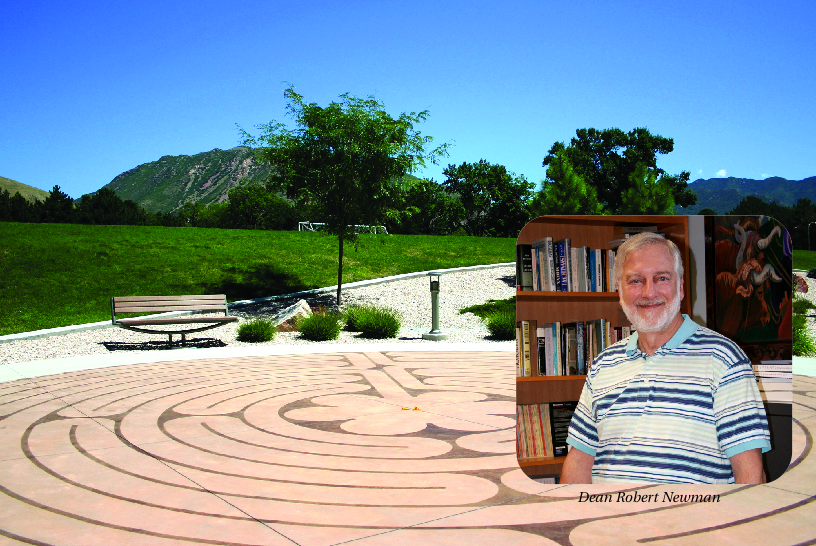
September activities at the labyrinth on the University of Utah campus.
A maze is a puzzle to be solved, defined by ambiguity, blind alleys and blocks. In contrast, a labyrinth is pilgrimage, where one path leads to the center and out again. It is traversed as a metaphor of the personal journey: inward, center and outward; releasing, receiving and returning; yin, yang and the interstitial opening in between. Its walk is contemplative, deliberate and restorative. The outline of the labyrinth is ancient—found throughout world cultures for at least 4,000 years.
“Everything in the labyrinth is metaphorical, a symbol of something else,” explains Robert Newman, Dean of the College of Humanities at the University of Utah. Hours prior to the autumnal equinox this month, Newman will present a lecture on this ancient meditation tool and lead a walk.
Newman became interested in labyrinths during a visit to the famed Chartres Cathedral labyrinth in France. He later spearheaded the construction of a replica on university grounds adjacent to the Carolyn Tanner Irish Humanities building. (See more on Dean Newman’s adventures and how the labyrinth came to be in the December 2008 CATALYST).
Labyrinth paths are spirals. “Scientists measuring brain waves and electrical activity have found that moving in a spiral pattern both calms the mind and stimulates areas which generally have low electrical activity,” says Newman. “Stepping into a labyrinth activates an energy field.”
To activate this field is to connect with the symbolic realm and move outside the rational. “Our daily experience can be overly rational and material. The idea of the walk is to calm what Buddhists call the ‘monkey mind.’ Taming the mind is a return to symbol and metaphor in our lives,” he says—critical for whole-brain thinking.
Last year Newman gave a talk about the labyrinth at a Humanities Happy Hour gathering. Afterward, he received many inquiries for more information.
The resulting upcoming event encompasses a background on the mythology, history and purpose of labyrinths, followed by a candlelit walk with medieval music. Newman hopes it will be a contemplative, meditative event, congruent with the labyrinth’s purpose.
Scholars are not sure why the labyrinth motif appears frequently in ancient cultures, but the construction of so many in cathedrals during medieval times indicates that the walk to the center and out again would have been a pilgrimage toward revelations of the divine. Although the labyrinth experience is highly individual—and yet, as obvious from its history, also universal—Newman points out that it provides a sense of centering, of taking time to reflect and being open to the possibility of illumination. 
While there is no one way to walk a labyrinth, the process usually mirrors classic journey myths. The long winding walk into the labyrinth path is for releasing or purging. It is a time to let go and quiet the noise of everyday life. Next is attaining the center, a time of opening to receive clarity or inspiration. Last is the walk out, a return to life or to the community, and bringing back insights gained. People go at their own pace, although part of the experience is to slow down and just be. Newman has seen some go quickly, some slowly, some dancing and some on their knees. As many times as he has walked a labyrinth — and he tries to as often as possible, even when traveling—he says he’s amazed to see how people quietly adjust to the others on the path; there is no impediment even for those with their eyes closed.
A labyrinth complements the intellectual realm with its ability to help people get unstressed and unstuck. The university’s labyrinth is outdoors, unfenced, and available to all who would walk it.
“The labyrinth is a gift on the part of the College of Humanities to the University community, so take advantage of it,” he says. For those who want more guidance, there is this month’s gathering. One request: Leave the cell phones behind.
Margaret Ruth is an author, writer and popular psychic in Salt Lake City. www.margaretruth.com
More info
For more background on the University of Utah Labyrinth, see CATALYST: “Learning in the Labyrinth,” Dec. 2008. (http://tinyurl.com/learninginthelabyrinth)
For the Worldwide Labyrinth Locator of the Labyrinth Society: http://labyrinthlocator.com/u
The Labyrinth Experience
Wed., September 21, 7pm
The Dean of the University of Utah College of Humanities, Robert Newman, will talk on the history, myth and metaphor of labyrinths and guide a candlelight walk of the Carolyn Tanner Irish Humanities Building Labyrinth. Meet at 215 South Central Campus Drive, Room 143. Cost is $25 ($15 for Humanities Happy Hour members). All proceeds support the College of Humanities Community Scholarships for Diversity Fund.
To register or for more information: 801-581-6214. http://www.hum.utah.edu/labyrinth
